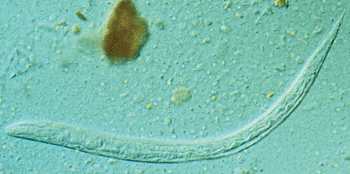Serologic Tests for Threadworm Infection Compared for Accuracy
By LabMedica International staff writers
Posted on 10 Feb 2014
The diagnosis of Strongyloides stercoralis or threadworm infection is hampered by the suboptimal sensitivity of fecal-based tests.Posted on 10 Feb 2014
There are several serological methods that are believed to be more sensitive than microscopy, although assessing their accuracy is difficult because of the lack of sensitivity of a fecal-based reference gold standard.

Image: Larva of the nematode parasite Strongyloides stercoralis (Photo courtesy of Centers of Disease Control and Prevention).
Microbiologists at the Sacro Cuore Hospital (Negra Verona, Italy) and their colleagues assessed the sensitivity and specificity of five serologic tests for S. stercoralis, three in-house and two commercially available, on 399 cryopreserved serum samples. Accuracy was measured using fecal results as the primary reference standard, but also using a composite reference standard based on a combination of tests.
The primary reference standard was direct detection of S. stercoralis larvae in stool, either through microscopy of at least three fecal samples after formol-ether concentration or Baermann, or stool agar/charcoal culture for S. stercoralis. Index serologic tests included three noncommercial tests: immunofluorescence antibody test (IFAT), recombinant Strongyloides antigen (NIE) enzyme-linked immunosorbent assay (NIE-ELISA) and the NIE- luciferase immunoprecipitation systems (NIE-LIPS). The two commercially available tests were the Bordier ELISA (Bordier Affinity Products; Crissier, Switzerland) and the SeroELISA Strongyloides IgG (IVD-ELISA) (IVD Research; Carlsbad, CA, USA).
The most sensitive test was IFAT, with 94.6% sensitivity, followed by IVD-ELISA with 92.3% sensitivity. The most specific test was NIE-LIPS, with specificity at 99.6%, followed by IVD-ELISA at 97.4%. NIE-LIPS did not cross-react with any of the specimens from subjects with other parasitic infections. NIE-LIPS and the two commercial ELISAs approach 100% specificity at a cut off level that maintains equal to or greater than 70% sensitivity.
The authors concluded that NIE-LIPS is the most accurate serologic test for the diagnosis of S. stercoralis infection. IFAT and each of the ELISA tests are sufficiently accurate, above a given cut off, for diagnosis, prevalence studies, and inclusion in clinical trials. IFAT loses sensitivity when gaining specificity at the optimal cut off for inclusion with a titer 1/160. The two commercially available ELISA tests showed reliable results in terms of accuracy and can also be used for inclusion in trials. The study was published on January 9, 2014, in the journal Public Library of Science Neglected Tropical Diseases.
Related Links:
Sacro Cuore Hospital
Bordier Affinity Products
IVD Research













